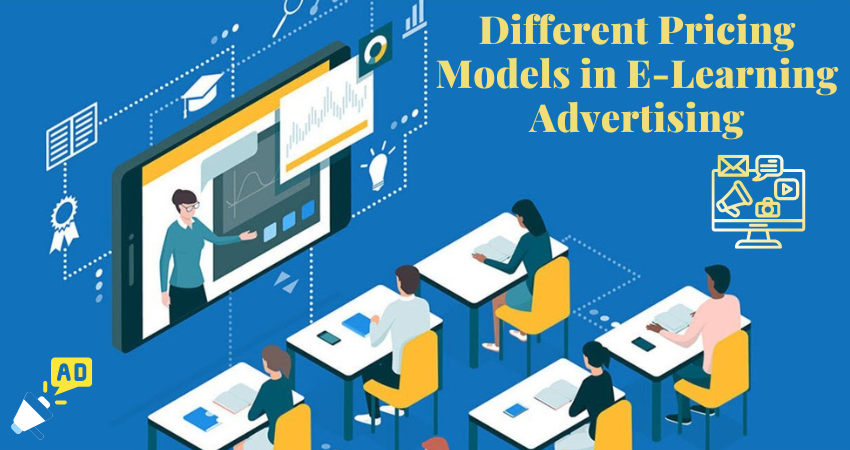Are you considering advertising your e-learning platform, but not sure which pricing model to adopt? Making a decision can be difficult with so many options available. But fear not! In this blog post, we’ll explore the pros and cons of different pricing models in e-learning advertising. From pay-per-click to subscription-based models, we’ll break down each option and give you the information you need to make an informed decision for your business. So buckle up and let’s dive into the world of e-learning advertising pricing models!
Overview of E-Learning Advertising
There are a few different ways that e-learning advertising can price their ads. The most common are cost-per-click (CPC), cost-per-impression (CPM), and flat rate. Each has advantages and cons of its own, making it crucial to select the best option for your company.
CPC: With this pricing model, you only pay when someone clicks on your ad. This is a good option if you have a limited budget and want to make sure your ad is seen by as many people as possible. However, it can be difficult to track the results of your ad campaign, and you may end up paying more than you would with other pricing models.
CPM: CPM stands for cost-per-mille, or cost per thousand impressions. With this model, you pay for every thousand times your ad is shown, regardless of whether it’s clicked on. This is a good option if you’re looking to build brand awareness or reach a large audience. However, it can be difficult to track the results of your ad campaign, and you may end up paying more than you would with other pricing models.
Flat-Rate: With this pricing model, you pay a fixed amount for your ad, regardless of how many people see it or how many clicks it gets. This is a good option if you have a large budget and want to ensure that your ad reaches a specific target audience.
Types of Pricing Models for E-Learning Advertising
There are four common types of pricing models for e-learning advertising: cost per view (CPV), cost per click (CPC), cost per acquisition (CPA), and cost per thousand impressions (CPM). Each model has its own benefits and drawbacks, so picking the best one for your company is crucial.
CPV: CPV is a popular pricing model for e-learning advertising. Under this model, you only pay when someone actually views your ad. This means that you can avoid paying for clicks that don’t lead to conversions. However, CPV can be expensive if your ad isn’t well-targeted, since you’re paying for every view regardless of whether it leads to a sale.
CPC: CPC is a less popular pricing model for e-learning advertising. Under this model, you pay every time someone clicks on your ad, regardless of whether they convert. This can be advantageous if you have a well-targeted ad campaign, since you’ll only pay for clicks that are likely to lead to sales. However, CPC can be expensive if your ads are not well-targeted, since you’ll be paying for clicks that don’t lead to conversions.
CPA: CPA is a popular pricing model for e-learning advertising. Under this model, you only pay when someone actually completes a desired action, such as making a purchase or signing up for a free trial.
Advantages and Disadvantages of Different Pricing Models
When it comes to e-learning advertising, there are a variety of pricing models that can be used. Each has its own advantages and disadvantages that should be considered before choosing a model.
Pay-Per-Click (PPC): PPC is a popular pricing model for e-learning advertising as it allows you to only pay when someone clicks on your ad. This can be a great way to control costs, but it can also result in low click-through rates if your ad is not well targeted.
Cost-Per-Mille (CPM): CPM is a pricing model that charges you based on the number of times your ad is seen, regardless of whether it is clicked on or not. This can be a good option if you have a very visible ad that is likely to be seen by many people. However, it can also end up being quite expensive if your ad isn’t well targeted.
Flat Rate: A flat rate is a single price that you pay for your e-learning advertisement. This can be a good option if you want to know exactly how much you will be spending on your ad campaign. However, it is important to make sure that the flat rate you choose is appropriate for the size and visibility of your ad.
Performance-Based: Performance-based pricing models charge you based on the results of your ad campaign.
Cost Considerations for Each Model
There are a few cost considerations to take into account when choosing a pricing model for e-learning advertising. The first is the cost of the actual product or service being advertised. If the product is expensive, it may not be feasible to use a pay-per-click or pay-per-impression model, as the cost of clicks or impressions would quickly add up. Instead, a flat fee or monthly subscription model would likely be more affordable.
Another cost consideration is the budget for the advertising campaign. A smaller budget may limit the ability to use a more expensive pricing model, such as CPM or CPC. In this case, a PPC or PPI model would be more affordable and still provide good results.
It is important to consider the expected return on investment (ROI) when choosing a pricing model. A higher priced model may have a higher ROI if it results in more sales or leads, while a lower priced model may have a lower ROI but be more affordable overall. It is important to weigh all of these factors when choosing a pricing model for an e-learning advertising campaign.
Strategies to Optimize the Pricing Model Choice
Choosing the right pricing model for your e-learning advertising can be a daunting task. There are so many factors to consider, and it’s hard to know which one will be the most effective for your business. In this blog post, we’ll explore the pros and cons of four different pricing models: cost per thousand impressions (CPM), cost per click (CPC), cost per acquisition (CPA), and subscription. We’ll also provide some strategies to help you optimize your choice of pricing model.
Cost per thousand impressions (CPM):
Pros: CPM is a simple and straightforward pricing model. You simply pay a set price for every 1,000 impressions your ad receives. This makes it easy to budget for your e-learning advertising campaign. Additionally, CPM allows you to reach a large audience with your ad since it is displayed on numerous websites.
Cons: CPM can be expensive, especially if your ad doesn’t receive a lot of clicks. Additionally, CPM doesn’t guarantee that your ad will be seen by potential customers since they may not scroll down to the part of the website where your ad is located.
Cost per click (CPC):
Pros: CPC is a more effective pricing model than CPM because you only pay when someone actually clicks on your ad. This means that you are only paying for interested customers who are more likely to convert into paying customers.
Conclusion
The e-learning market is full of opportunities, but it’s important to consider all the different pricing models before making your decision. Each model has pros and cons that you should be aware of. Pay-per-click models are great for quickly generating leads whereas subscription or membership models offer more stability over time. Whichever strategy you choose, proper research and implementation will ensure success in your marketing efforts.



